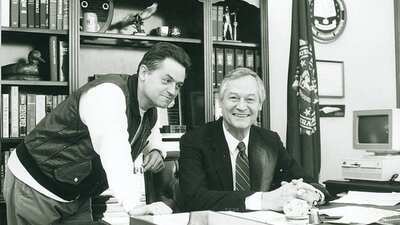Boris Karloff’s last film role was in the debut movie by film programmer and industry gadfly Peter Bogdanovich, “Targets,” about an assassin on the rampage at a drive-in movie theater where an elderly horror star named Byron Orlok (Karloff) is making a personal appearance; the film being shown on the drive-in screen is actually Corman’s “The Terror,” featuring none other than Boris Karloff. Bogdanovich got Karloff to star because Karloff still owed Corman two more days’ work as per their contract, and Corman had promised Bogdanovich he could do whatever he wanted as long as he brought the project in on time and on budget.
That Bogdanovich was able to reuse older Corman in “Targets” material placed him squarely in a proud tradition. Corman was one of the most ferociously dedicated recyclers in movie history. He often used sets, props, costumes and other items over and over throughout multiple productions, and took great pride in extracting every penny’s worth of value from things he’d paid for.
He shot one of his most famous and successful films, “Little Shop of Horrors” (remade as a Broadway musical, a musical film, and an animated TV series) on the same sets he’d used to shoot “Bucket of Blood.” Production lasted two days and one night, because that’s how long he had before the tear-down began. The first movie appearance by actor Dick Miller, a regular in Corman’s films as well as many films by Corman University alumni, was “Apache Woman.” He he told NPR that he was playing “an Indian” and midway through filming, “Corman asked him, “Would you like to play a cowboy?” Miller asked, “‘Doing another movie already?’ He says, ‘No, in the same movie.’ So I ended up playing a cowboy and an Indian in my first movie.” The only movie Corman ever did that got close to being called big-budget was the 1980 “Star Wars” cash-in “Battle Beyond the Stars,” which boasted miniature spaceship and blue-screen FX of such quality that Corman reused them in more Corman productions, including “Space Raiders,” “Starquest II,” “Vampirella,” “The Fantastic Four,” “Dead Space” and “Forbidden World.”
“Battle” is a wonderful film to zero in on as an example of Corman turning every project into a film school and making the result resonate beyond the boundaries of one movie. For starters, “Battle” gave an unknown artist and film crew grunt named James Cameron what he later called his “big break,” doing production design, art direction, prop fabrication, and anything else that was needed. He had been recommended by his then-girlfriend and future wife and coproducer Gale Anne Hurd (later the executive producer on multiple iterations of “The Walking Dead”), who was employed by Corman at the time. Cameron went on to direct his first feature for Corman, “Piranha II: The Spawning.” Actor Bill Paxton, who went to act for Cameron in four features, was a carpenter on “Piranha II.” Paxton also went on to star in one of the most highly regarded crime films of the 1990s, “One False Move,” which was directed by Carl Franklin. Franklin was Corman’s assistant for a time at Concord Pictures, and ended up directing three films for Corman. His debut feature, “Nowhere to Run,” starred David Carradine, a name that pops up often in Corman’s ’70s and ’80s credits.

